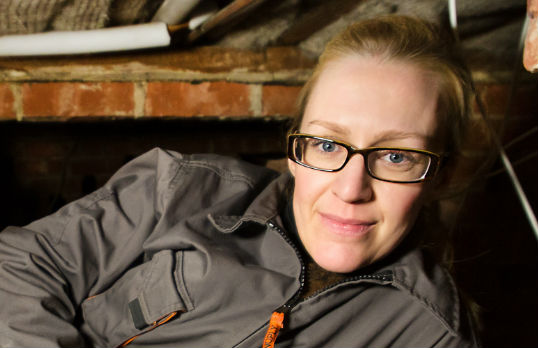Sofie is co-founder of Architecture for Change, a not-for-profit environmental building organisation. She is currently a doctoral researcher in building energy demand reduction at the UCL Energy Institute, investigating how best to reduce the heat-loss of pre-1919 un-insulated suspended timber ground floors. Sofie is author of ‘The Environmental Design Pocketbook’.

For a long while I thought I had to pretend that I didn’t come from a single-parent, low-income family.
The other students on my course were mostly from affluent, upper middle-class backgrounds and I felt like a misfit. I was too embarrassed to admit to them, or my tutors, that I was struggling for money, whilst also working part-time and caring for a vulnerable parent. The whole situation left me feeling isolated and I’m not sure how I made it through, but once I start something I don’t like giving up.
The other students on my course were mostly from affluent, upper middle-class backgrounds and I felt like a misfit. I’m not sure how I made it through, but once I start something I don’t like giving up.
When I began teaching I realised that I was doing both my students and myself a disservice by not being more open about my background. They were a very diverse group: most worked, lots had money worries, and many were coping with complex family situations. I think my own experience meant that I noticed when they were finding things difficult. I was able to check in with them and talk about practical options. I wish someone had done that for me and I suppose that’s one of the ways I think I have been a role model – or at least people tell me that I’ve helped them.
I have become increasingly aware that some students encounter more obstacles than others. I taught a talented black student who was the only one of his peers not to get a job, and a highly capable non-European woman who wasn’t able to secure an interview until she started using her husband’s English surname. It’s only when we talk openly about this kind of bias that we appreciate these issues are endemic. I use positive action; if I know someone is going to find it particularly tough then I help them to plan ahead, make links with industry and push them forward.
In Belgium I had been trained to design houses mostly for wealthy people, but I had nothing in common with that world. When I came to the UK I was free to pursue my own ideas and find out who I was as an architect. I had one teacher in particular who really listened to me and tried to bring out the best in me as an individual architect, which I think is what equality and diversity is all about. We shouldn’t be trying to create mini versions of ourselves, or just advocating one type of architecture that is dominated by a male, European, modernist viewpoint.
The fact that there is a greater diversity of students is in itself a good thing because they will change the face of the profession – if we can retain them. We need to open up to their ideas and what they bring to us, rather than expect them to fit into a traditional way of doing things.
The profession can be too constrained by its own claustrophobic view of what we, as architects, can do and contribute to society. We have to be far more creative about our own futures. It’s not just about becoming an associate, then a director or setting up our own practice. We can work flexibly, in multidisciplinary teams or even apply our skills to another field entirely. If we have a diverse pool of people then they are going to want different things from their careers.
The fact that there is a greater diversity of students is in itself a good thing because they will change the face of the profession – if we can retain them.
Most of architecture isn’t about the big, shiny, glass buildings. We have to keep on evolving as a profession in order to remain relevant. If we don’t show our own relevance to society, we will become an increasingly exclusive group that isn’t producing buildings that reflect ‘us out there’.









